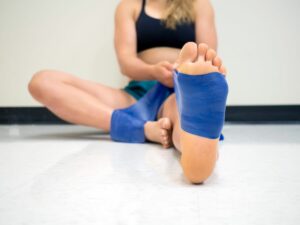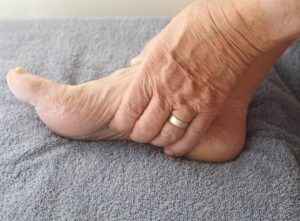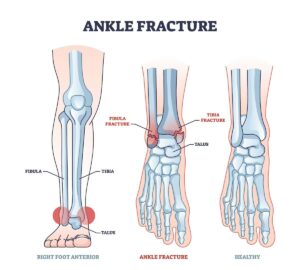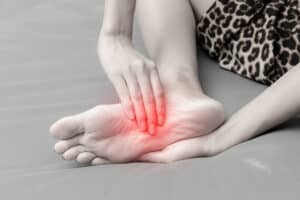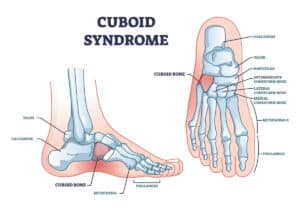Free download: Top 10 Natural & Easy Remedies for Joint Pain from Home. Learn these helpful remedies.
Estimated Reading Time: 10 minutes read
Any and all of the muscles and tendons in the body are susceptible to experiencing a strain injury. A hamstring strain is one of the most common areas you’ll usually hear about with this type of injury.
How do you know if you have a hamstring strain?
What can you do to heal quickly?
Let’s take a look!
Table of Contents
Hamstring Anatomy
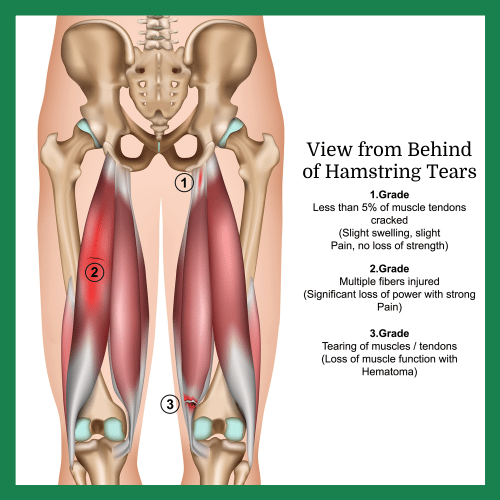
Three muscles collectively make up what we know as the hamstring muscles in the back of the thigh. They include the following:
- Semitendinosus
- Semimembranosus
- Biceps femoris
The tendon of each hamstring muscle has attachment points at the back of the hip and the back of the knee.
The action of the muscle attachments at the hip is hip extension. The action of the muscle attachments at the back of the knee is for knee flexion.
What is a Strain?
A strain is a specific injury to a muscle or tendon. It’s typically caused from overuse, excessive force or overstretching of the injured area.
Grades of a Hamstring Strain Injury:
When categorizing how severe a strain is, there are three grades to consider:
1. Grade 1: This is considered a mild strain. The muscle and/or tendon has been overstretched, with the start of possibly a small tear. You’ll notice stiffness but will still be able to move normally.
- Length of recovery: On average about 3 weeks of rest and recovery.
2. Grade 2: This is more severe than a Grade I, with a partial tear having occurred in the soft tissues, but no rupture. You may notice reduced range of motion in the injured area and some weakness.
- Length of Recovery: At least 1 month, possibly up to 3 months of rest and recovery.
3. Grade 3: This usually involves a complete muscle tear or tendon tear. You may notice bruising and/or swelling in the injured area. Depending on the severity, you may require immobilization of the area or possibly surgery.
- Length of Recovery: Anywhere from 6 months or up to 1 year.
How Does a Hamstring Strain Occur?
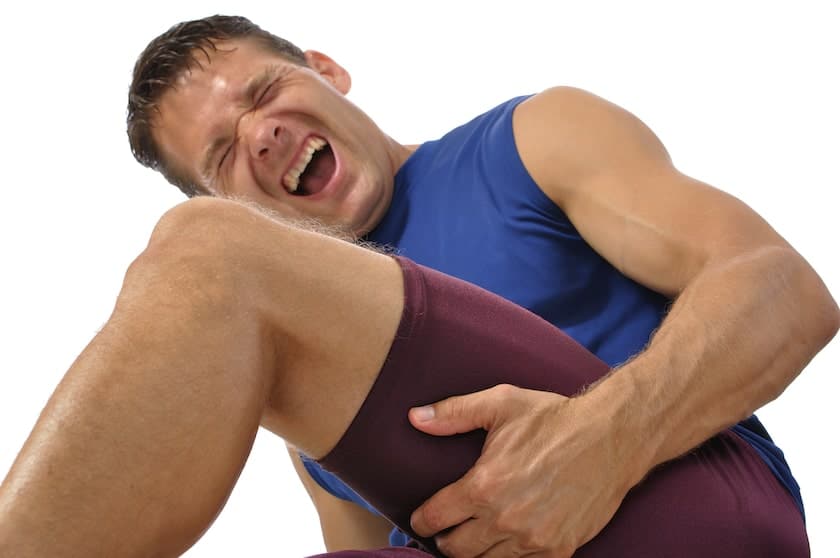
A hamstring strain is a type of muscle strain common in athletes, although can also occur in the non-athletic population.
Common sports and recreational activities with a higher risk of a hamstring strain includes the following:
- Football
- Tennis
- Soccer
- Runners or any activity that may require sprinting
- Dancers
- Basketball
These sports and activities tend to have a greater risk of placing excessive stress on the hamstring muscles, leading to a higher susceptibility of a strain.
Additional risk factors that can place you at a greater risk for a hamstring strain are observed in those with tight muscles and poor flexibility, presence of muscle imbalance, poor strength, and a previous hamstring injury.
Symptoms of a Hamstring Strain
If you think you may have a hamstring muscle strain, you may notice one or more of the following symptoms:
- Sudden sharp pain in the back of your thigh
- Popping sensation
- Swelling
- Tenderness
- Bruising
- Weakness
- Decrease range of motion
If you experience severe and sudden pain onset, it’s recommended to go to the emergency department to further assess your injury. They may perform imaging to assess the severity of your injured leg, such as magnetic resonance imaging (MRI).
Upon physical examination, once the doctor has determined the severity of the strain, an appropriate referral will be made, such as to physical therapy. Severe tears or ruptures sometimes require surgery, but this is not very common.
How to Heal a Hamstring Strain Fast?
Acute Phase of Injury: RICE
Immediately after the hamstring injury and strain, you’ll be in the acute phase of healing for up to 72 hours.
At this point, RICE will be your best friend. Rest, Ice, Compression, and Elevation. These measures are very important to help reduce swelling and manage pain.
Once past the acute, inflammatory phase of healing, you may even want to consider use of heat during recovery to provide better circulation to the injured leg and help relax stiffness in the muscles.
Pain Management
While healing, it’s important not to rush back to your prior activity level or sport right away. This can potentially cause further damage to the leg, further damage or tear the muscle tissue, and prolong the timeline and success of your healing.
If you have a more severe tear versus a mildly pulled hamstring, you may require additional pain management measures.
a. Medication
Your medical doctor may prescribe specific over the counter or actual prescription pain medications if the pain is severe enough.
If something is prescribed and what exactly is prescribed will of course depend on many factors, such as your age, medical history, and again severity of your injury.
b. Injections
If pain is being very stubborn and intense, keeping you from participating in other areas of your recovery, such as your physical therapy, you may require an injection to the injured leg, such as a steroid injection.
c. Physical Therapy
Physical therapy will be an important tool in your recovery process. The treatment plan will depend on the severity of your hamstring injury and limitations found during the initial assessment.
Treatment will likely consist of a variety of exercises, manual therapy, and use of other tools and modalities to assist with pain management and a full recovery.
d. Manual Therapy
Your physical therapist may incorporate manual therapy techniques to assist in recovery from your hamstring injury. These techniques may include massage, myofascial release, and trigger point release.
Some manual therapy techniques are more effective with the use of tools, such as instrument assisted soft tissue massage (IASTM), for example. IASTM has become more well-known and utilized to help with loosening scar tissue and promoting the healing process by activating necessary cells called fibroblasts.
Fibroblasts help to make collagen, which is an essential component of our connective tissues. This is important because these results can help speed your recovery process and return you to your prior activity level more quickly.
e. Modalities
Sometimes additional modalities will be used to assist in pain management, loosening of scar tissue, and reducing inflammation. A modality is a piece of equipment in a rehab facility used for the above purposes.
Common modalities you may see, if you’re an appropriate candidate, will include ultrasound, low level laser therapy, and electrical stimulation.
f. Taping
For additional support and pain management during activity, taping may also be applied, if appropriate. Taping can help the hamstring muscles to feel more stable and supported. Not only will this help to reduce pain but can also help you advance your activity level.
Exercises for Hamstring Strain
Exercises will typically consist of a variety of stretching and strengthening exercises.
The specific exercises prescribed will depend on your particular hamstring injury, however, there are a few basic exercises you might be given by your physical therapist that we’ll take a look at here as well.
1. Hamstring Stretch
We’ll talk about 2 basic stretches here. One that can target limited motion and reduced flexibility at the back of the knee, and the other at the back of the thigh. The stretches prescribed by your physical therapist will depend on the exact site of your hamstring strain.
a. Knee Extension Stretch via a Quad Set
For this stretch you will actually be contracting the quadricep muscles in the front of the thigh, however if your hamstring injury is located near the back of the knee, you’ll also feel a gentle stretch in that area too.

- Position yourself on your bed or couch with the injured leg stretched out in front of you. You can lay down or remain sitting upright.
- Gentle squeeze the top of the thigh, aiming to press the back of the knee down into the surface you’re on. Hold for 2 seconds. Return to your relaxed starting position.
- Repeat 10-15 repetitions for 2 sets.
- If you feel pain during this stretch, try to do a lighter squeeze with the thigh. If you feel you can hold the stretch for a few seconds longer without causing more pain, then go for it!
- This is a very gentle beginner’s stretch.
b. Hamstring Stretch with a Strap
This stretch can be a little more intense for the hamstring at both the back of the knee and back of the thigh, so be gentle.
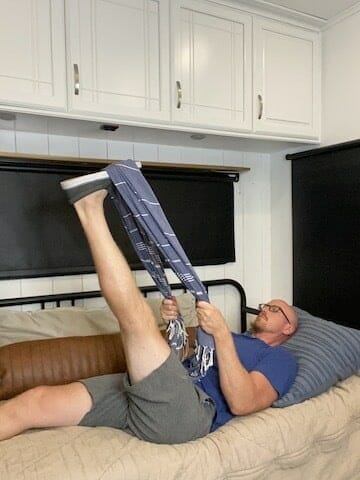
- Laying on your bed or couch, flat on the back, wrap a non-elastic strap around the foot of the injured leg.
- Keeping the knee as straight as you can tolerate, slowly and gently pull the leg up and towards the ceiling.
- Do not pull to the point of pain, only a gentle stretch.
- Aim to hold this stretch up to 30 seconds, if able, then lower down to your starting position.
- Repeat 2x.
2. Strengthening Exercises
As the hamstring injury continues to heal, you’ll want to gradually incorporate gentle strengthening exercises. While there may be a variety of exercises prescribed by your physical therapist, we’ll discuss 2 basic ones here geared towards the hamstring muscles.
a. Seated Hamstring Curl with a Resistance Band
This exercise will target the portion of the hamstring muscles near the back of the knee.

- While seated, tie a resistance band around both ankles.
- Place both feet slightly forward.
- Slowly begin to bend the knee on the injured leg, sliding the foot towards you.
- Bend the knee as far as your range of motion and pain will allow (don’t push into pain), then slowly return to your starting position.
- Repeat 10 repetitions for 2-3 sets.
- If you find this to be too easy, you can move your healthy, stabilizing leg more forward or use a heavier resistance band.
b. Prone Leg Extension
This exercise will target the hamstring muscles located near the back of the hip.
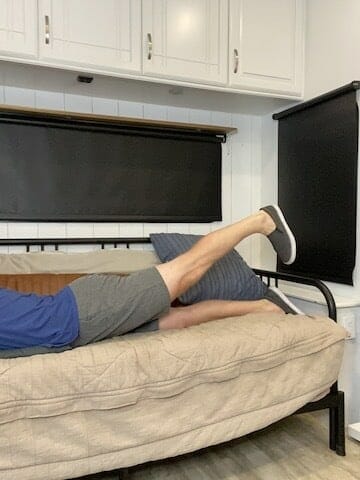
- Lay on your stomach on your bed or couch. You may want to place a pillow under the stomach for better spinal support.
- You can position your arms forward and place the forehead on your hands or forearms.
- Keeping the injured leg straight, slowly lift this leg 2-3 inches from the surface. Hold for 2 seconds, then lower back down.
- Repeat 10-15 repetitions for 2-3 sets.
3 Easy Ways to Do a Hamstring Curl
Here are three effective ways to target your hamstrings, while also allowing you to work other muscles in your legs as stabilizers.
Summary
A hamstring strain is very manageable but can take time and patience to heal. The severity of your injury will definitely affect your healing time and recovery, but with the right medical treatment and rehab compliance, you’ll be back to your old self in no time.
FAQ:
If I injured myself playing a specific sport, will I be able to play that sport again?
With a hamstring strain, there should be no reason you won’t be able to eventually return to your preferred sport. How soon you’ll get back will very much depend on the severity of your hamstring strain, and if any surgery was necessary.
How can I prevent a hamstring strain?
Make sure you practice a well-rounded exercise program. There should be an even balance of stretching and strengthening throughout this area.
For example, if you notice your hamstrings are incredibly tight, take the extra time to stretch them effectively. If you notice the hamstrings are a little weaker compared to the quads, make sure to add some additional strengthening exercises for them into your workout.
How often should I ice my hamstring strain?
Make sure to ice no more than 15-20 minutes at a time. Take at least a 30-minute break between icing sessions. With this in mind, you can ice several times per day.










